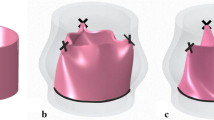Abstract
Tissue engineered heart valves equivalent to the native aortic heart valves are in development as an alternative to available prostheses. To achieve sufficient mechanical stiffness for application in tissue engineered valves exposed to the systemic circulation, the tissue is reinforced by a textile scaffold. Mechanical testing of structurally different textiles used as reinforcement in tissue engineered heart valves is expensive and time-consuming. The current study seeks to predict the behaviour of textile reinforced artificial heart valves using a multi-scale modelling approach. The complex textile structure was divided into simplified models at different scales. Virtual experiments were conducted on each of these models and their response was fitted by appropriate isotropic and anisotropic hyperelastic material models. The textile response was then used in a macro heart valve model, which was subjected to dynamic cardiac loading. It was shown that the current modelling approach is in good agreement with the real valve behaviour.



















Similar content being viewed by others
References
Iung B, Vahanian A (2011) Epidemiology of valvular heart disease in the adult. Nat Rev Cardiol 8(3):162–172
Novaro GM (2014) Aortic valve disease. http://www.clevelandclinicmeded.com/medicalpubs/diseasemanagement/cardiology/aortic-valve-disease/#top
Padala M, Keeling WB, Guyton RA, Thourani VH (2011) Innovations in therapies for heart valve disease. Circ J 75(5):1028–1041
Pibarot P, Dumesnil JG (2009) Prosthetic heart valves selection of the optimal prosthesis and long-term management. Circulation 119(7):1034–1048
Llames S, García E, Hernández JO, Meana Á (2012) Tissue bioengineering and artificial organs. In: López-Larrea C, López-Vázquez A, Suárez-Álvarez B (eds) Stem cell transplantation. Springer, Berlin, pp 314–336
Weber M, Heta E, Moreira R, Gesche VN, Schermer T, Frese J et al (2013) Tissue-engineered fibrin-based heart valve with a tubular leaflet design. Tissue Eng Part C Methods 20(4):265–275
Weinberg EJ, Mofrad MRK (2007) Transient, three-dimensional, multiscale simulations of the human aortic valve. Cardiovasc Eng 7(4):140–155
Weinberg EJ, Shahmirzadi D, Mofrad MRK (2010) On the multiscale modeling of heart valve biomechanics in health and disease. Biomech Model Mechanobiol 9(4):373–387
Argento G, Simonet M, Oomens C, Baaijens F (2012) Multi-scale mechanical characterization of scaffolds for heart valve tissue engineering. J Biomech 45(16):2893–2898
Goetz W, Lim H, Lansac E, Weber P, Duran C (2002) A temporarily stented, autologous pericardial aortic valve prosthesis. J Heart Valve Dis 11(5):696–702
Moreira R, Velz T, Alves N, Gesche VN, Malischewski A, Schmitz-Rode T et al (2014) Tissue-engineered heart valve with a tubular leaflet design for minimally invasive transcatheter implantation. Tissue Eng Part C Methods 21(6):530–540
Martins P, Natal Jorge R, Ferreira A (2006) A comparative study of several material models for prediction of hyperelastic properties: Application to silicone-rubber and soft tissues. Strain 42(3):135–147
Hibbitt D, Karlsson B, Sorensen P (2007) ABAQUS/Standard Analysis User’s Manual
Hassani B, Hinton E (1998) A review of homogenization and topology optimization I—homogenization theory for media with periodic structure. Comput Struct 69(6):707–717
Bednarcyk BA, Stier B, Simon JW, Reese S, Pineda EJ (2015) Meso- and micro-scale modeling of damage in plain weave composites. Compos Struct 121:258–270
Stapleton SE, Moreira R, Jockenhoevel S, Mela P, Reese S (2015) Effect of reinforcement volume fraction and orientation on a hybrid tissue engineered aortic heart valve with a tubular leaflet design. Adv Model Simul Eng Sci 2(1):1–17
Fung Y, Fronek K, Patitucci P (1979) Pseudoelasticity of arteries and the choice of its mathematical expression. Am J Physiol Heart Circ Physiol 237(5):H620–H631
Holzapfel GA, Gasser TC (2001) A viscoelastic model for fiber-reinforced composites at finite strains: continuum basis, computational aspects and applications. Comput Methods Appl Mech Eng 190(34):4379–4403
Reese S (2003) Meso–macro modelling of fibre-reinforced rubber-like composites exhibiting large elastoplastic deformation. Int J Solids Struct 40(4):951–980
Holzapfel GA (2004) Computational biomechanics of soft biological tissue. In: Stein E, De Borst R, Hughes TJR (eds) Encyclopedia of computational mechanics, solids and structures, chap 18, vol 2. Wiley, London
Gasser TC, Ogden RW, Holzapfel GA (2006) Hyperelastic modelling of arterial layers with distributed collagen fibre orientations. J R Soc Interface 3(6):15–35
Ehret AE, Itskov M (2007) A polyconvex hyperelastic model for fiber-reinforced materials in application to soft tissues. J Mater Sci 42(21):8853–8863
Arruda EM, Boyce MC (1993) A three-dimensional constitutive model for the large stretch behavior of rubber elastic materials. J Mech Phys Solids 41(2):389–412
Humphrey JD (1994) Mechanics of the arterial wall: review and directions. Crit Rev Biomed Eng 23(1–2):1–162
Lechat C, Bunsell AR, Davies P (2011) Tensile and creep behaviour of polyethylene terephthalate and polyethylene naphthalate fibres. J Mater Sci 46(2):528–533
Sodhani D, Stier B, Reese S (2015) Evaluating the simulation of ideal filler reinforced elastomers using a full field modelling approach. Const Models Rubber IX:317
Acknowledgments
This research was partially funded by the Integrated Interdisciplinary Institute of Technology for Medicine (I3TM) of RWTH Aachen University, through the Seed-Fund SF-14-04-08, “Hybrid scaffold for a transcatheter tissue engineered aortic valve”. Additional funding was provided by the People Programme (Marie Curie Actions) of the European Union’s Seventh Framework Programme FP7/2007-2013-ITN ‘TECAS’ under REA Grant Agreement 317512. The authors would additionally like to thank Bertram Stier for his script to apply periodic boundary conditions and for helpful discussion and support.
Author information
Authors and Affiliations
Corresponding author
Rights and permissions
About this article
Cite this article
Sodhani, D., Reese, S., Moreira, R. et al. Multi-scale modelling of textile reinforced artificial tubular aortic heart valves. Meccanica 52, 677–693 (2017). https://doi.org/10.1007/s11012-016-0479-y
Received:
Accepted:
Published:
Issue Date:
DOI: https://doi.org/10.1007/s11012-016-0479-y




